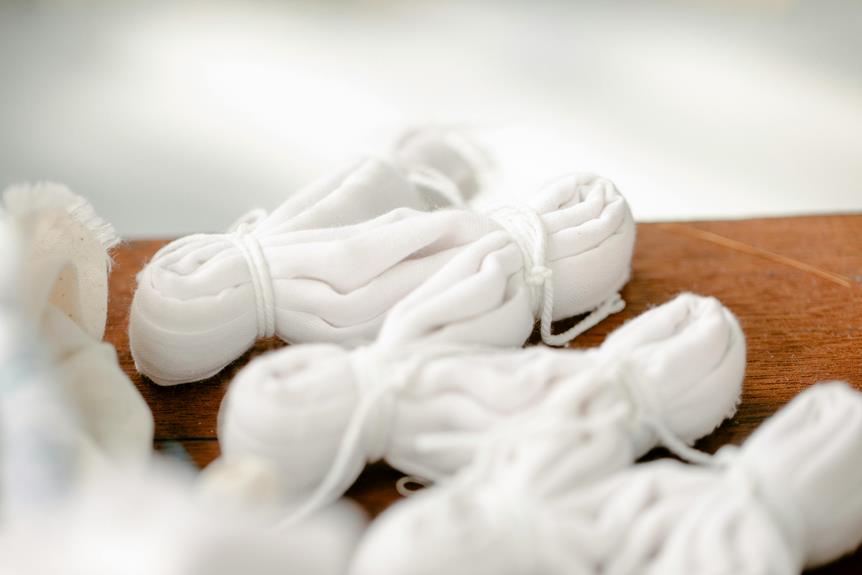When you're sewing with pinpoint fabric, it's essential to approach it with precision and care. You'll need to start by preparing your fabric properly—pre-washing and ironing are crucial steps. Choosing the right tools, like sharp scissors and a Microtex needle, can make all the difference in achieving clean edges. As you navigate through the various stitch types and tension settings, you might find that even small adjustments can lead to significant improvements in your project's outcome. But what happens when you run into unexpected challenges?
Table of Contents
Understanding Pinpoint Fabric
Pinpoint fabric, known for its fine weave and smooth texture, is a versatile choice that combines durability with a polished appearance. This fabric typically features a blend of cotton and polyester, making it not only breathable but also easy to care for. When you work with pinpoint fabric, you'll appreciate its lightweight nature, which lends itself well to various projects, from shirts to dresses.
Understanding its characteristics is crucial for successful sewing. The fabric's tight weave means it resists fraying, but you should still use a sharp needle to prevent snagging. Keep in mind that pinpoint fabric can be a bit slippery, so using clips instead of pins can help maintain its alignment while you sew.
Before you start, always pre-wash your fabric to prevent shrinkage and to remove any chemicals. Ironing it before cutting can help you achieve clean edges and accurate measurements.
As you sew, maintain a steady pace; this will help you navigate the fabric's smooth surface and ensure even stitching. Overall, pinpoint fabric's refined look and feel make it an excellent choice for projects that require both style and sturdiness.
Essential Sewing Tools
When sewing with pinpoint fabric, having the right tools is crucial for achieving the best results.
You'll need must-have supplies, the right needle types, and appropriate threads to ensure your project goes smoothly.
Let's explore these essential items to set you up for success.
Must-Have Sewing Supplies
You'll need some essential sewing tools to work effectively with pinpoint fabric. Start with a good pair of fabric scissors; they'll help you cut clean edges without fraying. A rotary cutter and mat can also be invaluable for precise cuts, especially for straight lines.
Next, invest in a reliable sewing machine. Make sure it has adjustable stitch settings to accommodate the lightweight nature of pinpoint fabric. A walking foot will help prevent slipping, ensuring even feeding through the machine.
You'll also want a variety of pins and clips. Use fine pins to secure the fabric without causing damage, or opt for fabric clips for thicker layers. Don't forget to have a seam ripper on hand for those inevitable mistakes.
A measuring tape and clear ruler are essential for accurate measurements and cutting. Finally, keep a good supply of thread in matching colors, as pinpoint fabric can be tricky to match.
With these tools, you'll set yourself up for success and make working with pinpoint fabric a breeze. Enjoy the process and happy sewing!
Recommended Needle Types
Choosing the right needle for your sewing machine is crucial for working effectively with pinpoint fabric. Since this type of fabric is lightweight and delicate, using the appropriate needle will help you achieve the best results without causing damage. Here are some recommended needle types to consider:
| Needle Type | Size | Purpose |
|---|---|---|
| Universal Needle | 70/10 | Ideal for general sewing |
| Microtex Needle | 60/8 | Perfect for precision work |
| Ballpoint Needle | 75/11 | Suitable for knit fabrics |
Using a Universal Needle is a great starting point, as it works well with various fabrics, including pinpoint. If you're working on projects that require more precision, the Microtex Needle is your best bet. Its sharp point can easily penetrate the fabric without causing snags. On the other hand, if you're sewing with knit blends, the Ballpoint Needle will help you avoid damaging the fibers.
Choosing Appropriate Threads
To achieve the best results with pinpoint fabric, selecting the right thread is just as important as choosing the correct needle.
You'll want to opt for a thread that complements the lightweight and delicate nature of pinpoint fabric. A fine thread, such as a 50 or 60-weight polyester or cotton, works well, as it provides strength without adding bulk.
Avoid thicker threads that can create unwanted tension and puckering. When it comes to color, choose a thread that closely matches your fabric to ensure clean seams. If you're working with contrasting colors, consider how the thread will impact the overall look of your project.
Always test your thread choice on a scrap piece of fabric before you begin your main project. This way, you can assess the stitch quality and ensure that the thread behaves as expected.
If you find that your chosen thread is causing issues, don't hesitate to try a different type or brand. Ultimately, a carefully selected thread can make a significant difference in the final appearance and durability of your pinpoint fabric creations.
Preparing Your Fabric
Before you begin sewing with pinpoint fabric, it's essential to properly prepare your material for the best results. Taking these steps will ensure your fabric behaves as expected and enhances your finished project.
- Prewash the Fabric: Wash your pinpoint fabric according to its care instructions. This removes any sizing or chemicals and helps prevent future shrinkage.
- Iron the Fabric: After washing, iron your fabric to eliminate any wrinkles. A smooth surface is crucial for accurate cutting and sewing.
- Cut with Precision: Use sharp scissors or a rotary cutter for clean edges. Pinpoint fabric can fray, so cut carefully to maintain the integrity of the edges.
- Stabilize if Necessary: If your pinpoint fabric is particularly lightweight, consider using a stabilizer to prevent shifting during sewing. This will help maintain your desired shape and prevent puckering.
Choosing the Right Stitch
When you're sewing with pinpoint fabric, picking the right stitch is crucial for achieving a clean finish.
You'll need to consider the type of stitch, adjust the tension for optimal results, and decide on the appropriate stitch length.
Each of these factors plays a significant role in how your final project turns out.
Stitch Type Selection
Choosing the right stitch for pinpoint fabric can make all the difference in achieving a polished and professional finish. This lightweight fabric requires careful consideration of stitch types to maintain its delicate structure while ensuring durability.
Here are some popular stitch options you should consider:
- Straight Stitch: Ideal for seams, it provides a clean and simple line. Use a shorter stitch length for added strength.
- Zigzag Stitch: Perfect for finishing edges, a zigzag stitch helps prevent fraying, especially on curved seams.
- French Seam: This technique encases raw edges, making it perfect for sheer and lightweight fabrics. It creates a neat finish and adds strength.
- Narrow Rolled Hem: This stitch is excellent for hems on pinpoint fabric. It gives a polished look while keeping the bulk minimal.
Tension Adjustment Tips
To achieve the best results with pinpoint fabric, you need to carefully adjust the tension on your sewing machine. Pinpoint fabric is lightweight and may shift easily, so proper tension ensures that your seams are secure and even.
Start by testing different tension settings on a scrap piece of fabric. Aim for a balanced stitch where both the top thread and bobbin thread meet in the middle of the fabric layers.
If you notice puckering, it's a sign that your tension is too tight. Loosen the top tension slightly and test again. Conversely, if your stitches appear loose or the fabric is gathering, tighten the tension a bit.
Remember, pinpoint fabric often behaves differently than heavier materials, so don't hesitate to make adjustments during your project.
Additionally, consider the type of thread you're using. A finer thread may require lower tension settings, while thicker threads might need more tension for a secure stitch.
Always keep your sewing machine clean and well-maintained, as dirt or lint can affect tension too. By taking the time to adjust your machine's tension, you'll achieve cleaner, more professional results with your pinpoint fabric sewing projects.
Stitch Length Considerations
Adjusting the stitch length is just as important as fine-tuning the tension when working with pinpoint fabric, as it can greatly impact the overall appearance and durability of your seams.
Choosing the right stitch length helps you achieve a neat finish without compromising the fabric's integrity. Here's what you should consider:
- Fabric Weight: Use shorter stitches (1.5-2.5mm) for lightweight pinpoint fabrics to prevent puckering.
- Seam Strength: Longer stitches (2.5-3.5mm) provide more flexibility but may reduce seam strength. Find a balance based on your project needs.
- Type of Stitch: For decorative stitches, you might need longer length settings to maintain the design's clarity.
- Sewing Speed: If you're sewing quickly, opt for a medium stitch length (2.5-3.0mm) to allow for slight adjustments as you go.
Experimenting with these considerations ensures you find the perfect stitch length for your pinpoint fabric.
Remember that a well-chosen stitch length not only elevates your work but also enhances the longevity of your finished piece. Always test on a scrap piece first to see how your adjustments affect the fabric!
Tips for Cutting Fabric
When cutting pinpoint fabric, make sure to use sharp scissors or a rotary cutter for clean edges and precise shapes. A dull blade can snag or pull at the fabric, resulting in uneven cuts. Always lay your fabric flat on a cutting mat to prevent slipping.
Before you start cutting, it's a good idea to pre-wash and press your fabric to eliminate any shrinkage or wrinkles. This step ensures you're working with the most accurate dimensions. Use weights or pins to secure the fabric in place, especially if it has a tendency to shift.
For straight cuts, consider using a ruler or straightedge as a guide. If you're cutting curves or intricate shapes, take your time and follow the lines carefully. Avoid cutting too quickly; a steady hand leads to better results.
Lastly, remember to cut with the grain of the fabric whenever possible. This practice helps maintain the integrity of the fabric and ensures that your finished pieces drape correctly. By following these tips, you'll achieve clean cuts and prepare your pinpoint fabric for sewing with confidence.
Techniques for Seam Finishing
Finishing seams properly not only enhances the durability of your pinpoint fabric project but also gives it a polished look. You've put in the effort to create something beautiful, so don't overlook this crucial step.
Here are some effective techniques for seam finishing:
- Zigzag Stitch: This is a quick and easy method. Simply sew a zigzag stitch along the raw edges to prevent fraying.
- French Seams: Perfect for lightweight fabrics like pinpoint, French seams encase the raw edges. Start by sewing the fabric with wrong sides together, trim the seam allowance, then sew again with right sides together.
- Serger: If you have access to a serger, it's an excellent choice for finishing seams. The machine trims and overlocks the edges simultaneously, creating a professional finish.
- Bias Binding: For a decorative touch, consider using bias binding. Sew the binding along the edge of the seam, folding it over to cover the raw edge completely.
Caring for Your Finished Project
Caring for your finished pinpoint fabric project ensures it stays vibrant and lasts for years to come. To maintain the quality of your fabric, follow these essential care tips:
- Washing: Use cold water and a gentle cycle. Avoid bleach to protect the fabric's color and texture.
- Drying: Air dry your project whenever possible. If you must use a dryer, opt for a low heat setting to prevent shrinkage.
- Ironing: If wrinkles occur, iron on the reverse side using a low heat setting. A pressing cloth can help prevent damage.
- Storage: Store your fabric items in a cool, dry place. Use breathable materials like cotton bags to avoid moisture buildup.
- Spot Cleaning: For minor stains, spot clean with mild detergent and a soft cloth instead of washing the entire item.
| Care Tip | Description |
|---|---|
| Washing | Use cold water and gentle cycle |
| Drying | Air dry or low heat setting in the dryer |
| Ironing | Iron on reverse side with low heat |
| Storage | Store in a cool, dry place with breathable bags |
| Spot Cleaning | Use mild detergent and soft cloth for stains |
Frequently Asked Questions
Can I Use a Regular Sewing Machine for Pinpoint Fabric?
Yes, you can use a regular sewing machine for pinpoint fabric. Just ensure you have the right needle and thread, and adjust the tension settings. It'll help you achieve a smooth and even stitch.
What Type of Needle Is Best for Pinpoint Fabric?
When sewing pinpoint fabric, you'll want to use a fine needle, typically a size 70/10 or 80/12. This ensures you get clean, precise stitches without damaging the delicate fibers of the fabric.
Is Pinpoint Fabric Suitable for Beginners?
Yes, pinpoint fabric's lightweight nature makes it suitable for beginners. You'll find it easy to handle, and it allows for simple sewing techniques. Just remember to use the right needle and thread for the best results.
How Do I Prevent Pinpoint Fabric From Fraying?
To prevent fraying, you can use a serger or zigzag stitch along the edges. Alternatively, try applying Fray Check or a similar fabric sealant. Always handle the fabric gently to reduce wear during sewing.
Can I Wash Pinpoint Fabric Before Sewing?
Yes, you can wash pinpoint fabric before sewing. It helps remove any sizing or chemicals. Just make sure to follow the care instructions, and let it dry completely before you start your sewing project.
- How Does Ring Spun Cotton Affect Garment Fit and Shape Retention? - August 13, 2024
- What Are the Challenges in Producing Ring Spun Cotton? - August 13, 2024
- Is Ring Spun Cotton Suitable for Plus-Size Clothing? - August 13, 2024






